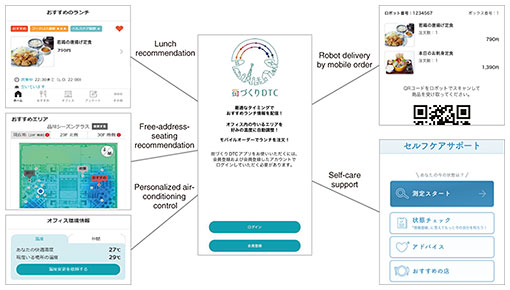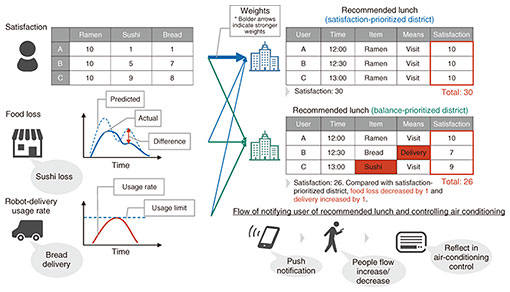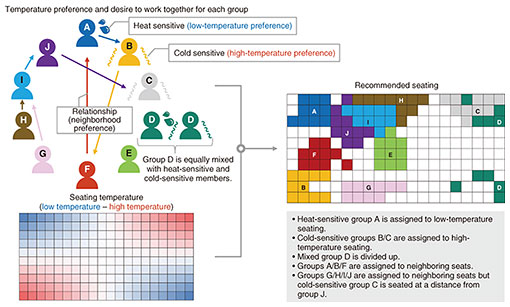 |
|||||||||||||||
|
|
|||||||||||||||
|
Feature Articles: Urban DTC for Creating Optimized Smart Cities Attentive to the Individual Vol. 22, No. 5, pp. 56–63, May 2024. https://doi.org/10.53829/ntr202405fa7 Urban District Experiences for the Individual Generated by the Linking of Digital Twins—Digital-twin-integrated Platform and Integrated AppAbstractAn urban district includes a variety of stakeholders each with their own interests with trade-offs existing among those interests. The digital-twin-integrated platform was developed to achieve social well-being by calculating a state that obtains a balance among those trade-offs on the basis of values predicted by multiple digital twins. An integrated app was also developed that provides services for the individual based on pre- and post-behavior context by determining behavior spanning multiple services using a single identifier. Keywords: urban DTC, digital-twin-integrated platform, integrated app 1. Total district optimization by Digital Twin ComputingAn urban district consists of people, things, and environmental factors that influence each other in complex ways, which is why representing a district by a single digital twin (DT) is difficult. We therefore take the following alternative approach. First, we model a DT for each industry domain making up the district, next, we model the DT of a person mediating among multiple DTs, and finally, we apply linking*1 to the DTs and model their mutual interaction by Digital Twin Computing (DTC) (Fig. 1).
Since each DT has a different objective, running a DT independently may give rise to competition among different DTs. For example, the objective of a DT for a restaurant (zero-food-loss DT) is to minimize food loss on the premise that food loss occurs in accordance with the difference between the predicted values and actual values of the number of customers, sales figures for each menu item, etc. However, forcing people to visit other restaurants for the sake of controlling food loss competes with the DT of a person whose objective is to maximize personal satisfaction (personal-service DT). There is therefore a trade-off between food-loss control and personal satisfaction—minimizing food loss and maximizing satisfaction cannot be achieved simultaneously. This makes it necessary to find an optimal solution that achieves a balance between food loss and satisfaction. Given multiple objective functions as in the case of minimizing food loss and maximizing satisfaction, the task of finding an optimal solution that achieves a balance among those functions is called a multi-objective optimization problem*2. In this type of problem, an optimal solution is not uniquely determined. Rather, multiple optimal solutions form a curved line (in the case of two objective functions) or curved surface (in the case of three or more objective functions). This curved line or curved surface is called the Pareto front (Fig. 2). The process of linking DTs and modeling their mutual interaction by DTC means formulating a multi-objective optimization problem in relation to multiple linked DTs and determining the Pareto front.
The objective with DTC is to provide new value by achieving total optimization of a district beyond optimization achieved independently by a single DT. It is used to determine a state of social well-being that achieves balanced trade-offs among multiple DTs by first solving the multi-objective optimization problem then feeding back those results to the real world to achieve that state by automatically controlling the environment, influencing people’s behavior, etc. There is therefore a need for base functions that connect DTs to conduct total optimization calculations and provide the results of those calculations to external systems via an application programming interface (API). There is also a need for an application that encourages behavior modification by providing a person with optimal content by an optimal means of communication at an optimal time.
2. Digital-twin-integrated platformThe digital-twin-integrated platform (DT-integrated platform) achieves the base functions described above. It corresponds to the DTC layer in urban DTC architecture [1] and consists of a DT-connection function, total-optimization function, API, etc. (Fig. 3). The DT-connection function is an input/output interface to the DTs. It takes the predicted values of each DT as input to the total-optimization function and outputs the results of total-optimization calculations for environmental control (such as air-conditioning control) to specific DTs. The total-optimization function executes DTC as the core function of the DT-integrated platform. The API, meanwhile, is an input/output interface to external systems. It takes the log obtained from the customer-contact app and outputs the results of total-optimization calculations for influencing people’s behavior to the customer-contact app.
The total-optimization function presents two main issues. The first is formulating the multi-objective optimization problem for multiple linked DTs, and the second is determining the Pareto front in a realistic period. First, problem formulation means determining how to provide the results of striking a balance among multiple DTs as value in the form of concrete services given certain types and a certain number of DTs, which means that such formulation can take on different forms. Ideally, total optimization would be executed immediately after connecting DTs to the DT-integrated platform, but automatically interpreting the complex interaction among people, things, and the environment is difficult. We therefore envisioned a variety of specific services, such as lunch recommendation and free-address-seating recommendation, and formulated the problem for each. Details of those two services are described later as case studies. Next, we solved the problem of determining the Pareto front in a realistic period by dividing total optimization into two parts: overall adjustment and partial modification. Overall adjustment is executed in a state in which real-world objects (restaurants, people, etc.) corresponding to each DT are inactive such as during the night or early morning. It is a computational process that sets up an all-day action plan based on the predicted value of each DT. Partial modification, on the other hand, is executed in response to a previously set trigger condition (e.g., food loss surpasses a certain threshold) in a state in which real-world objects corresponding to each DT are active. It is a computational process that compensates for the differences in the action plan created in the overall adjustment process. Overall adjustment and partial modification can be used to partially change the action plan depending on the situation even while setting up the overall action plan. This approach prevents a situation in which overall adjustment is repeatedly executed whenever a trigger occurs so that the next computational process begins before the previous computational process completes, which would prevent computational processing from being completed in a realistic period. 3. Integrated appThe integrated app encourages behavior modification as described earlier. It corresponds to urban DTC architecture [1] and the customer-contact app in Fig. 3. This app provides services oriented to the district user such as lunch recommendation, free-address-seating recommendation, personalized air-conditioning control, robot delivery by mobile order, and self-care support (Fig. 4).
To achieve a state of social well-being envisioned with the DT-integrated platform, it will be necessary to encourage people to behave as envisioned. A commonly used approach to this end had been to determine user preferences based on past service-usage logs and to encourage behavior through recommendations based on those preferences. However, in a district that provides multiple services, making such recommendations on a service-by-service basis is insufficient from the viewpoint of improving the user experience of value within an urban district. We believe that this can be achieved by connecting user experiences of value spanning multiple services as a series of behavioral paths (journey), determining user preferences across multiple services, and predicting user behavior on the basis of transitions in service usage. We call this process “value-journey-type behavior prediction.” To achieve value-journey-type behavior prediction, a single identifier (ID) must be used to continuously keep track of the behavior of a user using multiple services. The integrated app achieves this by executing authentication with the member base connected to the DT-integrated platform, enabling one-stop use of the services provided by DTs and DTC with a single ID. The usage logs of multiple services are accumulated in the DT-integrated platform as training data, enabling look-ahead behavior prediction based on pre- and post-behavior context. 4. Case studiesThe following introduces lunch recommendation and free-address-seating recommendation as specific case studies of using the DT-integrated platform and integrated app. 4.1 Case study 1: Lunch recommendationThe integrated app notifies the user of a lunch recommendation when arriving at the office or heading out to lunch. It determines a recommended lunch (time, menu, means) for each user through total optimization of three DTs: the personal-service DT, restaurant zero-food-loss DT, and mobility DT*3. The district-management DT controls air conditioning considering that the number of customers visiting a restaurant changes in accordance with recommendations. If all members take lunch as recommended, a totally optimized state can be achieved that strikes a balance among satisfaction, food loss (difference between the predicted and actual values of the sales figures for each menu item), and the usage rate of robot delivery. By controlling air conditioning in a proactive manner in accordance with predictions of an increase or decrease in people flow, a totally optimized state can also be achieved that strikes a balance between thermal comfort and energy cost. In making a lunch recommendation, food loss and usage rate of robot delivery are treated as a penalty with regard to user satisfaction, so we formulated this recommendation by converting the multi-objective optimization problem for three DTs to a single-objective optimization problem using the weighting method*4. In single objective optimization, no Pareto front is formed since an optimal solution is uniquely determined, but if the solution space is a convex set, the set of optimal solutions obtained by varying the weights becomes a Pareto front. Since we can imagine the owners of district businesses thinking of a district in the manner of “I would like to create a district with high user satisfaction” or “I would like to create a district with little food loss,” we adopted a design that approaches the actualization of various district concepts by varying the strengths of the weights. The concept of recommending any one of three menu items to each of three users is shown in Fig. 5. All members like ramen but differ in the degree to which they like sushi and bread. The situation is such that food loss is likely to occur for sushi that includes raw fish and that there is leeway in the usage rate of robot delivery. The results of total optimization for recommending lunch are shown at the right of the figure. Compared with a satisfaction-prioritized district, the balance-prioritized district results in no significant drop in satisfaction while lowering food loss and improving the usage rate of robot delivery. Business owners in the district may even desire to lower food loss even more and increase the usage rate of robot delivery even if satisfaction drops further. They can make adjustments in this regard by varying the strengths of the weights. Since the flow of people headed to restaurants will decrease through the use of robot delivery, this situation can be reflected in air-conditioning control such as by turning down air conditioning on the restaurant floor.
In a demonstration experiment involving lunch recommendations conducted at the URBANNET NAGOYA nexta BUILDING from February to March 2023 [2], it was confirmed that the linking of four DTs could operate as expected. 4.2 Case study 2: Free-address-seating recommendationIn this case study, the integrated app recommends an available seat at which work can be efficiently done to users arriving at work. It determines which seat to recommend through total optimization of two DTs, personal-service DT and district-management DT. If all members take their seat as recommended, a totally optimized state can be achieved that strikes a balance between thermal comfort (temperature at which work can be comfortably done) and distance from people that the user wants to work with. To make free-address-seating recommendations, we formulated the problem by treating thermal comfort as a constraint on the distance between the user and people that the user wants to work with and converting the multi-objective optimization problem for two DTs to a single-objective optimization problem using the constraint method*5. However, there are problems that must be addressed when using the constraint method. For example, the Pareto front cannot be understood unless the constraint is varied multiple times, and a solution may not be found if the constraint is excessively severe. If thermal comfort is expressed in terms of the difference in temperature at the user’s desired seat and recommended seat, however, the range of acceptable temperature difference can be estimated to some extent beforehand, so we judged that there were no problems in this use case. Considering that taking a seat or changing seats as recommended may not necessarily occur, we decided to conduct optimization calculations assuming that the rate of moving to a recommended seat depends on the user and recommend a section consisting of users with a low moving rate to a user with a high moving rate. The concept of arranging seating for ten groups of people each consisting of ten individuals is shown in Fig. 6. It is assumed that people have temperature preferences in terms of heat or cold sensitivity even within the same group and that some groups have a relationship in terms of wanting to work together, as indicated with the arrows in the figure. It is also assumed that we have a state that allows for conditions that produce uneven temperatures instead of uniform cooling or heating, thus reducing energy costs. The recommended seating shown at the right of Fig. 6 is the result of total optimization. Heat- and cold-sensitive groups are seated in accordance with seat temperatures and that groups who wish to work together are seated near each other.
We have been conducting a demonstration experiment on making free-address-seating recommendations since November 2023 at an office building owned by an NTT Group company.
5. Future developmentsAlong with an increase in DTs for each industry domain, we can expect an increase in use cases that will require trade-off solutions. We can also expect specific initiatives in modeling by urban DTC to accumulate from here on and progress to be made in achieving a general-purpose platform by identifying and consolidating common functions. To achieve a state of social well-being envisioned by the DT-integrated platform, it will be necessary to encourage people to behave as envisioned. There are limits, however, to the information-recommendation approach, so we plan to implement a more effective approach in the integrated app that drives behavior modification through, for example, nudges and incentives. Going forward, we will continue to promote research and development to achieve smart cities in which an entire district takes shape in cyber space by harmonizing multiple DTs and district experiences for the individual are obtained in physical space. References
|
|||||||||||||||

















